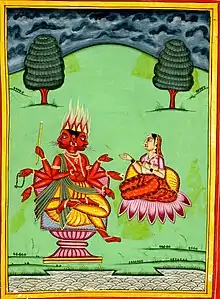Svaha
Svaha (Sanskrit: स्वाहा, IAST: Svāhā), also referred to as Manyanti, is the Hindu goddess of sacrifices featured in the Vedas.[4] She is the consort of Agni, and the daughter of either Daksha or Brihaspati, depending on the literary tradition. According to the Brahmavaivarta Purana, she is an aspect of Prakriti (nature), an element without which Agni cannot sustain.[5]
| Svaha | |
|---|---|
Goddess of Sacrifices[1] | |
 Agni with Svaha | |
| Affiliation | Devi |
| Abode | Agniloka |
| Mantra | Om Svaha |
| Personal information | |
| Parents | Daksha (father) and Prasuti (mother)[lower-alpha 1] |
| Consort | Agni[3] |
| Children | Pavaka, Pavamana, Shuchi, Agneya, Skanda[2] |
Additionally, in Hinduism, the Sanskrit lexical item svāhā (romanized Sanskrit transcription; Devanagari: स्वाहा; Khmer: ស្វាហា; Thai: สวาหะ; Chinese: 薩婆訶, sà pó hē, Japanese: sowaka; Tibetan: སྭཱ་ཧཱ་ sw'a h'a; Korean: 사바하, sabaha; Vietnamese : ta bà ha) is a denouement used at the end of a mantra, which is invoked during yajna fire sacrifices and worship.[6] Svāhā is chanted to offer oblation to the gods.[7][8] As a feminine noun, svāhā in the Rigveda may also mean oblation (to Agni or Indra). Svaha is also considered to mean an auspicious ending.
Etymology
Etymologically, the Sanskrit term derives from the root words सू sū- "good" and आहा -āhā "to call".[8][9]
Legends
Svaha is personified as a goddess and as the consort of Agni. According to the Brahmavidya Upanishad, Svaha represents the shakti or power that cannot be burned by Agni.[10] In the Upanishads, Svaha confesses to be enamoured by Agni and wishes to dwell with him. Hence, the deities state that oblations would be offered to Agni while invoking her name during hymns, allowing Svaha to dwell with Agni in perpetuity.[11]
In some versions, she is one of the many divine mothers of Kartikeya (Skanda). She is also the mother of Agneya (Aagneya) — the daughter of Agni. She is considered to be a daughter of Daksha and his consort Prasuti. She is thought to preside over burnt offerings. Her body is said to consist of the four Vedas and her six limbs are considered to be the six Angas of the Vedas.
Story
In the Mahabharata Vana Parva, Markandeya narrates her story to the Pandavas. Svaha was the daughter of Daksha. She fell in love with the God of Fire, Agni, and was pursuing him. Agni did not notice her. He presided over the sacrificial rituals of the Saptarishis. The deity became highly besotted with the wives of the Saptarishis who were so ravishing that he kept staring at them.
Finally, Agni could not bear the guilt of longing for wives belonging to someone else and he went to the forests to perform penances. Svaha followed him and understood his desire. She took the forms of the wives of the Saptarishis (though she was unable to take the form of Arundhati, wife of Vashishtha) and approached Agni six times, seducing him and throwing the seed of each union into a golden pot, from which Skanda was born.[12]
Literature
Brahmanda Purana
The Brahmanda Purana mentions the names of the children of Svaha: Pavamāna, Pāvaka, and Śuci.[13]
Devi Bhagavata Purana
In the Devi Bhagavata Purana, Narayana offers Narada the procedure to meditate upon Svaha:[14]
The following is the Dhyānam (meditation) of Svāhā Devī :-- O Devī Svāhā! Thou art embodied of the Mantras; Thou art the success of the Mantras; Thou art Thyself a Siddhā; Thou givest success and the fruits of actions to men; Thou dost good to all. Thus meditating, one should offer Pādya (water for washing the feet), etc., uttering the basic Mantra; success then comes to him. Now hear about the Radical Seed Mantra. The said mantra (Mūla mantra) is this :-- “Om Hrīm Śrīm Vahnijāyāyai Devyai Svāhā.” If the Devī be worshipped with this Mantra, all the desires come to a successful issue.
— Devi Bhagavata Purana, Book 9, Chapter 43
Notes
- In some texts, Svaha is mentioned as the daughter of Brihaspati and Tara.[2]
References
- Hertel, Bradley R.; Humes, Cynthia Ann (January 1993). Living Banaras: Hindu Religion in Cultural Context. SUNY Press. ISBN 9780791413319.
- Dalal, Roshen (18 April 2014). Hinduism: An Alphabetical Guide. Penguin UK. ISBN 9788184752779.
- Antonio Rigopoulos (1998). Dattatreya: The Immortal Guru, Yogin, and Avatara: A Study of the Transformative and Inclusive Character of a Multi-faceted Hindu Deity. State University of New York Press. p. 72. ISBN 978-0-7914-3696-7.
- Hertel, Bradley R.; Humes, Cynthia Ann (1 January 1993). Living Banaras: Hindu Religion in Cultural Context. SUNY Press. p. 232. ISBN 978-0-7914-1331-9.
- Dalal, Roshen (18 April 2014). Hinduism: An Alphabetical Guide. Penguin UK. ISBN 978-81-8475-277-9.
- Pal, Ankit (September 2020). "why do we say swaha at the end of Mantra during Havan". newstrend.news. Newstrend. Retrieved 4 March 2021.
- Cappeller, Carl (1891). A Sanskrit-English Dictionary, Based Upon the St. Petersburg Lexicons. K. Paul.
- Franco, Rendich (14 December 2013). Comparative etymological Dictionary of classical Indo-European languages: Indo-European - Sanskrit - Greek - Latin. Rendich Franco.
- "The mantric word svaha". www.visiblemantra.org. Retrieved 4 March 2021.
- Dalal, Roshen (18 April 2014). Hinduism: An Alphabetical Guide. Penguin UK. ISBN 978-81-8475-277-9.
- Original Sanskrit texts on the origin and progress of the religion and institutions of India. Williams and Norgate. 1863.
- Hertel, Bradley R.; Humes, Cynthia Ann (1 January 1993). Living Banaras: Hindu Religion in Cultural Context. SUNY Press. p. 232. ISBN 978-0-7914-1331-9.
- www.wisdomlib.org (12 June 2019). "The race of Agni [Chapter 12]". www.wisdomlib.org. Retrieved 18 September 2022.
- www.wisdomlib.org (15 May 2013). "On the history of Svāhā [Chapter 43]". www.wisdomlib.org. Retrieved 18 September 2022.
